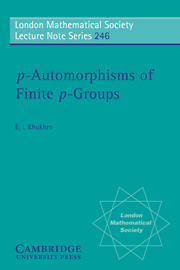Book contents
- Frontmatter
- Contents
- Preface
- Introduction
- Chapter 1 Preliminaries
- Chapter 2 Automorphisms and their fixed points
- Chapter 3 Nilpotent and soluble groups
- Chapter 4 Finite p-groups
- Chapter 5 Lie rings
- Chapter 6 Associated Lie rings
- Chapter 7 Regular automorphisms of Lie rings
- Chapter 8 Almost regular automorphism of order p: almost nilpotency of p-bounded class
- Chapter 9 The Baker–Hausdorff Formula and nilpotent ℚ-powered groups
- Chapter 10 The correspondences of A. I. Mal'cev and M. Lazard
- Chapter 11 Powerful p-groups
- Chapter 12 Almost regular automorphism of order pn: almost solubility of pn-bounded derived length
- Chapter 13 p-Automorphisms with p fixed points
- Chapter 14 Automorphism of order p with pm fixed points: almost nilpotency of m-bounded class
- Bibliography
- Index of names
- Subject Index
- List of symbols
Chapter 13 - p-Automorphisms with p fixed points
Published online by Cambridge University Press: 22 October 2009
- Frontmatter
- Contents
- Preface
- Introduction
- Chapter 1 Preliminaries
- Chapter 2 Automorphisms and their fixed points
- Chapter 3 Nilpotent and soluble groups
- Chapter 4 Finite p-groups
- Chapter 5 Lie rings
- Chapter 6 Associated Lie rings
- Chapter 7 Regular automorphisms of Lie rings
- Chapter 8 Almost regular automorphism of order p: almost nilpotency of p-bounded class
- Chapter 9 The Baker–Hausdorff Formula and nilpotent ℚ-powered groups
- Chapter 10 The correspondences of A. I. Mal'cev and M. Lazard
- Chapter 11 Powerful p-groups
- Chapter 12 Almost regular automorphism of order pn: almost solubility of pn-bounded derived length
- Chapter 13 p-Automorphisms with p fixed points
- Chapter 14 Automorphism of order p with pm fixed points: almost nilpotency of m-bounded class
- Bibliography
- Index of names
- Subject Index
- List of symbols
Summary
In the extreme case, where a p-automorphism of a finite p-group has only P fixed points, the result is extremely strong.
Theorem 13.1.If a finite p-group P admits an automorphism φ of order pn with exactly P fixed points, then P has a subgroup of (p,n)-bounded index which is nilpotent of class at most 2 (abelian, if P = 2).
For |φ| = p this was proved by C. R. Leedham-Green and S. McKay [1976] and by R. Shepherd [1971]; in the general case it was proved by S. McKay [1987] and by I. Kiming [1988].
We give a proof which is different from the original ones; although with possibly worse bounds for the index of the subgroup, our proof is more Lie ring oriented, making use of Higman's and Kreknin's Theorems from Chapter 7, the theory of powerful p-groups from Chapter 11, and the Lazard Correspondence from Chapter 10. As in Chapters 8 and 12, bounds for the ranks of abelian sections allow us to assume P to be powerful. Using a generalization of Maschke's Theorem, one can show that every (φ-invariant abelian section is a kind of “almost one-dimensional” ℤ〈φ〉-module. This information is used in a reduction to the case where P is uniformly powerful, and later in the proof of a Lie ring theorem. An application of Higman's Theorem to a subring of the associated Lie ring L(P) allows us to assume P to be nilpotent of class h(p), the value of Higman's function.
- Type
- Chapter
- Information
- p-Automorphisms of Finite p-Groups , pp. 151 - 165Publisher: Cambridge University PressPrint publication year: 1998

